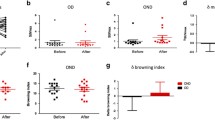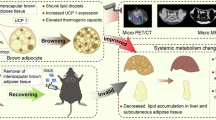Abstract
Background
Bariatric surgery is an effective treatment for obesity causing changes in energy expenditure. Brown adipose tissue (BAT) is an energy-related organ, and the potential effects of bariatric surgery are yet to be investigated. We aimed to study the effects of different bariatric surgeries on growth hormone/insulin-like growth factor-1 (GH/IGF-1) axis, brown adipocyte differentiation, and energy metabolism in obese mice and explore the underlying mechanisms.
Methods
Mice were fed a high-fat diet for 12 weeks and subjected to different bariatric procedures: adjustable gastric band (AGB), sleeve gastrectomy (SG), Roux-en-Y gastric bypass (RYGB), and sham operation (SO). Pre- and postoperative weight, a metabolic index, content, and metabolic activity of BAT was recorded by micro-positron emission tomography/computed tomography (micro-PET/CT). Altered energy metabolism was estimated by metabolic cage technology. Serum GH/IGF-1 level and the brown adipose cell differentiation-related gene expression were estimated.
Results
By postoperative week 4, serum GH and IGF-1 levels, as well as the content and metabolic activity of BAT increased postoperatively. The differentiation factors of the brown adipose cell were significantly stronger, energy consumption increased, and respiratory exchange frequency decreased postoperative. The effect was predominant in RYGB; SG demonstrated superior result to ABG. With weight regain 8-week postoperation, these parameters deteriorated in the operation groups, significantly in the GB group; the RYGB group seemed superior to the SG group.
Conclusions
Bariatric surgery elevated the GH/IGF-1 levels and increased BAT volume and activity, meanwhile decreasing the respiratory exchange frequency. This may help us better understand the mechanisms of bariatric surgery.








Similar content being viewed by others
Explore related subjects
Discover the latest articles and news from researchers in related subjects, suggested using machine learning.References
Ng M, Fleming T, Robinson M, et al. Global, regional, and national prevalence of overweight and obesity in children and adults during 1980-2013: a systematic analysis for the Global Burden of Disease Study 2013. Lancet. 2014;384(9945):766–81.
Schauer PR, Bhatt DL, Kirwan JP, et al. Bariatric surgery versus intensive medical therapy for diabetes—3-year outcomes. N Engl J Med. 2014;370(21):2002–13.
Miras AD, le Roux CW. Mechanisms underlying weight loss after bariatric surgery. Nat Rev Gastroenterol Hepatol. 2013;10(10):575–84.
Bueter M, Lowenstein C, Olbers T, et al. Gastric bypass increases energy expenditure in rats. Gastroenterology. 2010;138(5):1845–53.
Hao Z, Mumphrey MB, Townsend RL, et al. Body composition, food intake, and energy expenditure in a murine model of Roux-en-Y gastric bypass surgery. Obes Surg. 2016;26(9):2173–2182.
Shin AC, Zheng H, Townsend RL, et al. Longitudinal assessment of food intake, fecal energy loss, and energy expenditure after Roux-en-Y gastric bypass surgery in high-fat-fed obese rats. Obes Surg. 2013;23(4):531–40.
Virtanen KA, Lidell ME, Orava J, et al. Functional brown adipose tissue in healthy adults. N Engl J Med. 2009;360(15):1518–25.
Bartelt A, Bruns OT, Reimer R, et al. Brown adipose tissue activity controls triglyceride clearance. Nat Med. 2011;17(2):200–5.
Vijgen GH, Bouvy ND, Teule GJ, et al. Increase in brown adipose tissue activity after weight loss in morbidly obese subjects. J Clin Endocrinol Metab. 2012;97(7):E1229–33.
Baraboi ED, Li W, Labbe SM, et al. Metabolic changes induced by the biliopancreatic diversion in diet-induced obesity in male rats: the contributions of sleeve gastrectomy and duodenal switch. Endocrinology. 2015;156(4):1316–29.
Hankir M, Bueter M, Gsell W, et al. Increased energy expenditure in gastric bypass rats is not caused by activated brown adipose tissue. Obes Facts. 2012;5(3):349–58.
Hankir MK, Bronisch F, Hintschich C, et al. Differential effects of Roux-en-Y gastric bypass surgery on brown and beige adipose tissue thermogenesis. Metabolism. 2015;64(10):1240–9.
Cordido F, Alvarez-Castro P, Isidro ML, et al. Comparison between insulin tolerance test, growth hormone (GH)-releasing hormone (GHRH), GHRH plus acipimox and GHRH plus GH-releasing peptide-6 for the diagnosis of adult GH deficiency in normal subjects, obese and hypopituitary patients. Eur J Endocrinol. 2003;149(2):117–22.
Ursavas A, Karadag M, Ilcol YO, et al. Low level of IGF-1 in obesity may be related to obstructive sleep apnea syndrome. Lung. 2007;185(5):309–14.
Gram IT, Norat T, Rinaldi S, et al. Body mass index, waist circumference and waist-hip ratio and serum levels of IGF-I and IGFBP-3 in European women. Int J Obes. 2006;30(11):1623–31.
Eden Engstrom B, Burman P, Holdstock C, et al. Effects of gastric bypass on the GH/IGF-I axis in severe obesity—and a comparison with GH deficiency. Eur J Endocrinol. 2006;154(1):53–9.
Louveau I, Gondret F. Regulation of development and metabolism of adipose tissue by growth hormone and the insulin-like growth factor system. Domest Anim Endocrinol. 2004;27(3):241–55.
Bruinsma BG, Uygun K, Yarmush ML, et al. Surgical models of Roux-en-Y gastric bypass surgery and sleeve gastrectomy in rats and mice. Nat Protoc. 2015;10(3):495–507.
Zechner JF, Mirshahi UL, Satapati S, et al. Weight-independent effects of roux-en-Y gastric bypass on glucose homeostasis via melanocortin-4 receptors in mice and humans. Gastroenterology. 2013;144(3):580–90. e7
Chujo Y, Fujii N, Okita N, et al. Caloric restriction-associated remodeling of rat white adipose tissue: effects on the growth hormone/insulin-like growth factor-1 axis, sterol regulatory element binding protein-1, and macrophage infiltration. Age (Dordr). 2013;35(4):1143–56.
Bluher S, Kratzsch J, Kiess W. Insulin-like growth factor I, growth hormone and insulin in white adipose tissue. Best Pract Res Clin Endocrinol Metab. 2005;19(4):577–87.
Munzberg H, Laque A, Yu S, et al. Appetite and body weight regulation after bariatric surgery. Obes Rev. 2015;16 Suppl 1:77–90.
Cleveland-Donovan K, Maile LA, Tsiaras WG, et al. IGF-I activation of the AKT pathway is impaired in visceral but not subcutaneous preadipocytes from obese subjects. Endocrinology. 2010;151(8):3752–63.
O’Sullivan AJ, Kelly JJ, Hoffman DM, et al. Body composition and energy expenditure in acromegaly. J Clin Endocrinol Metab. 1994;78(2):381–6.
Smas CM, Sul HS. Control of adipocyte differentiation. Biochem J. 1995;309(Pt 3):697–710.
Bartelt A, Heeren J. Adipose tissue browning and metabolic health. Nat Rev Endocrinol. 2014;10(1):24–36.
Lee P, Linderman JD, Smith S, et al. Irisin and FGF21 are cold-induced endocrine activators of brown fat function in humans. Cell Metab. 2014;19(2):302–9.
Roman S, Agil A, Peran M, et al. Brown adipose tissue and novel therapeutic approaches to treat metabolic disorders. Transl Res. 2015;165(4):464–79.
Seale P, Bjork B, Yang W, et al. PRDM16 controls a brown fat/skeletal muscle switch. Nature. 2008;454(7207):961–7.
Cypess AM, Kahn CR. Brown fat as a therapy for obesity and diabetes. Curr Opin Endocrinol Diabetes Obes. 2010;17(2):143–9.
Manning S, Pucci A, Batterham RL. Roux-en-Y gastric bypass: effects on feeding behavior and underlying mechanisms. J Clin Invest. 2015;125(3):939–48.
Wilms B, Ernst B, Schmid SM, et al. Enhanced thermic effect of food after roux-en-Y gastric bypass surgery. J Clin Endocrinol Metab. 2013;98(9):3776–84.
Faria SL, Faria OP, Cardeal Mde A, et al. Diet-induced thermogenesis and respiratory quotient after Roux-en-Y gastric bypass. Surg Obes Relat Dis. 2012;8(6):797–802.
Cardeal MA, Faria SL, Faria OP, et al. Diet-induced thermogenesis in postoperative Roux-en-Y gastric bypass patients with weight regain. Surg Obes Relat Dis. 2016;12(5):1098–107.
Faria SL, Faria OP, Cardeal Mde A, et al. Diet-induced thermogenesis and respiratory quotient after Roux-en-Y gastric bypass surgery: a prospective study. Surg Obes Relat Dis. 2014;10(1):138–43.
Abegg K, Corteville C, Bueter M, et al. Alterations in energy expenditure in Roux-en-Y gastric bypass rats persist at thermoneutrality. Int J Obes. 2016;40(8):1215-21.
Kohli R, Setchell KD, Kirby M, et al. A surgical model in male obese rats uncovers protective effects of bile acids post-bariatric surgery. Endocrinology. 2013;154(7):2341–51.
Pournaras DJ, Glicksman C, Vincent RP, et al. The role of bile after Roux-en-Y gastric bypass in promoting weight loss and improving glycaemic control. Endocrinology. 2012;153(8):3613–9.
Werling M, Olbers T, Fandriks L, et al. Increased postprandial energy expenditure may explain superior long term weight loss after Roux-en-Y gastric bypass compared to vertical banded gastroplasty. PLoS One. 2013;8(4):e60280.
Pournaras DJ, le Roux CW. Are bile acids the new gut hormones? Lessons from weight loss surgery models. Endocrinology. 2013;154(7):2255–6.
Wang K, Zhou X, Quach G, et al. Effect of sleeve gastrectomy plus side-to-side jejunoileal anastomosis for type 2 diabetes control in an obese rat model. Obes Surg. 2016;26(4):797–804.
Chambers AP, Jessen L, Ryan KK, et al. Weight-independent changes in blood glucose homeostasis after gastric bypass or vertical sleeve gastrectomy in rats. Gastroenterology. 2011;141(3):950–8.
Funding
The work was supported by Shanghai Pudong New District Population and Family Planning Commission (CN), China (Grant PW2014D-5).
Author information
Authors and Affiliations
Corresponding author
Ethics declarations
Conflict of Interest
The authors declare that they have no conflict of interest.
Statement of Animal Rights
All the procedures were performed in accordance with Shanghai Jiaotong University guidelines for the use of animals, with the approval of The Animal Care and Utilization Committee of Shanghai Jiaotong University. All animals were housed under standard conditions with free access to water and food.
Electronic Supplementary Material
Supplementary Table 1
(DOCX 14 kb)
Supplementary Table 2
(DOCX 13 kb)
Rights and permissions
About this article
Cite this article
Chen, Y., Yang, J., Nie, X. et al. Effects of Bariatric Surgery on Change of Brown Adipocyte Tissue and Energy Metabolism in Obese Mice. OBES SURG 28, 820–830 (2018). https://doi.org/10.1007/s11695-017-2899-8
Published:
Issue Date:
DOI: https://doi.org/10.1007/s11695-017-2899-8




